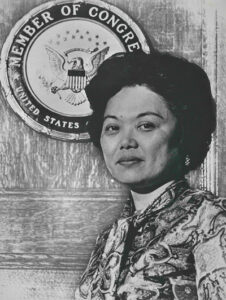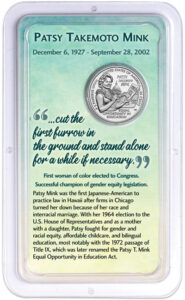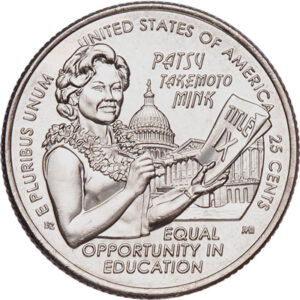Mrs. Mink Goes to Washington

For Patsy Takemoto Mink, the halls of Congress were a long way from her birth on a Maui sugar plantation. The granddaughter of working-class Japanese immigrants, Patsy was born when Hawaii was just a U.S. territory. Let’s take a look at her remarkable journey that led to this groundbreaking Congresswoman’s honor on the 12th circulating coin of the U.S. Mint’s new quarter series.
From the Islands to the Mainland
From high school valedictorian and class president, Patsy enrolled as a pre-med student at the University of Nebraska. There, she was assigned segregated housing for students of color and international students. Objecting, Patsy successfully got students, professors, alumni and local community members to protest the discrimination. Within the year, the university reversed its policy.
Equality still proved elusive, however. More than 10 medical schools refused her admission based on her gender. So, Patsy made the difficult choice to change her career dreams. In 1948, she was accepted to the University of Chicago Law School; she was one of only two women in her class.

Patsy earned her law degree; married fellow graduate student, geologist John Mink; had their daughter, Gwendolyn in 1952, and then returned to Hawaii with her family. In 1953, Patsy Mink passed the state bar exam. But law firms wouldn’t hire a woman in an interracial marriage and a mother.
Again, Patsy switched her professional horizon, saying later, “Not being able to get a job from anybody changed things.” She opened her own law practice and took cases that larger firms turned down. Not surprisingly, most involved family and women issues, such as adoption and divorce.
In 1956, Patsy ran for Hawaii’s House of Representatives. Her decision to knock on doors paid off with a win, making her the first woman to serve in Honolulu. Two years later, voters elected her to the territory’s Senate, again making her the first woman to serve in that chamber. From both stints, Patsy gained valuable experience drafting statues, including a regulation dubbed “equal pay for equal work”, plus successfully pushing for more public funds to be spent on education.
But after statehood was achieved in 1959, her subsequent bid to represent Hawaii in Congress failed. Voters sent fellow Japanese-American Daniel Inouye instead.
Mrs. Mink Finally Goes to Washington
After the 1960 census came out, Hawaii obtained a second seat in the U.S. House. Patsy Mink mounted a new campaign to represent her home state in the nation’s capital – and won! Commented one historian, “[It] broke every rule of American politics: she was Japanese, she was a woman, and she was married to a white man (haole).” Patsy was 36.
According to the Library of Congress, Patsy was part of a small, but growing number of women getting elected to Congress. In 1972, they helped pass the Equal Rights Amendment.
That year, they also helped push through Patsy’s groundbreaking amendment to the Higher Education Act. Known as Title IX, it prohibited discrimination on the basis of gender at educational institutions receiving federal funds. While Title IX’s most reported and visible change was to give equal funding to women’s athletic programs, it did much more. Women got academic opportunities to pursue coursework for careers that had been largely closed to them, notably law and medicine.

The reverse of her 2024 quarter features Patsy holding her landmark Title IX legislation. In the background, the U.S. Capitol Building prominently features the south wing, home to the U.S. House of Representatives. This coin’s designer was Beth Zaiken of the U.S. Mint’s Artistic Infusion Program and the sculptor was John P. McGraw, Medallic Artist with the mint.
“It is easy enough to vote right and be consistently with the majority,” Patsy observed during a 1976 interview. “But it is more often more important to be ahead of the majority and this means being willing to cut the first furrow in the ground and stand alone for a while if necessary.”
Two years later, Patsy Mink successfully shepherded passage of the 1974 Women’s Educational Equity Act (WEEA), which allocated federal monies for gender equity in public schools. Among other programs, it funded innovative work to increase math and science achievement for girls and female participation in non-traditional careers.
“We have to build things that we want to see accomplished, in life and in our country, based on our own personal experiences to make sure that others do not have to suffer the same discrimination,” Patsy told the Honolulu Star-Bulletin in an interview published October 8, 1975.
It’s interesting to note that the ‘70s decade represented a watershed period in Hawaii’s history and its contributions to U.S. history. In addition to Patsy’s trailblazing achievements, Edith Kanaka’ole set out to preserve the Indigenous Polynesians’ way of life on the islands. She, too, was honored on a new U.S. Women’s Quarter. Find out more about Edith on this Heads & Tails blog article. If you’ve enjoyed both or either, you are welcome to leave a comment!
SOURCES:
5 Things to Know about Rep. Patsy Mink, the First Woman of Color in … https://www.genderontheballot.org/5-things-to-know-about-rep-patsy-mink/?shem=ssusxt=
Bell, Danna. “Patsy Takemoto Mink’s Title IX Legacy.” Library of Congress Blog. June 23, 2022. https://blogs.loc.gov/teachers/2022/06/patsy-takemoto-minks-title-ix-legacy/
Cruz, Tania & Yamamoto, Eric K. “A Tribute to Patsy Takemoto Mink.” Asian-Pacific Law & Policy Journal; Vol. 4, Issue 2 (summer 2003). https://scholarspace.manoa.hawaii.edu/server/api/core/bitstreams/5d57364b-a3ff-4f4d-bbae-4f8808336869/content
“Life Story: Patsy Mink (1927-2002).” https://wams.nyhistory.org/growth-and-turmoil/feminism-and-the-backlash/patsy-mink/?shem=ssusxt
Nakamura, Kelli Y. “Patsy Mink.” Densho Encyclopeida. https://encyclopedia.densho.org/Patsy_Mink/
National Park Service. “Patsy Mink.” https://www.nps.gov/people/patsy-mink.htm?shem=ssusxt=
National Women’s History Museum. https://www.womenshistory.org/education-resources/biographies/patsy-mink?shem=ssusxt
“Patsy Takemoto Mink Educational Foundation for Low-Income Women and Children.” https://www.patsyminkfoundation.org/
Stanford Libraries. Stanford University. “Rise Up for Asian Americans and Pacific Islanders, Together, we rise up to overcome anti-AAPI hate.” Accessed December 5, 2023. https://exhibits.stanford.edu/riseup/feature/patsy-mink
Tzu-Chun Wu, Judy and Mink, Gwendolyn. “How Patsy Takemoto Mink, the First Woman of Color in Congress, Helped Craft Title IX.” June 1, 2022. https://time.com/6174298/patsy-takemoto-mink-title-ix/



